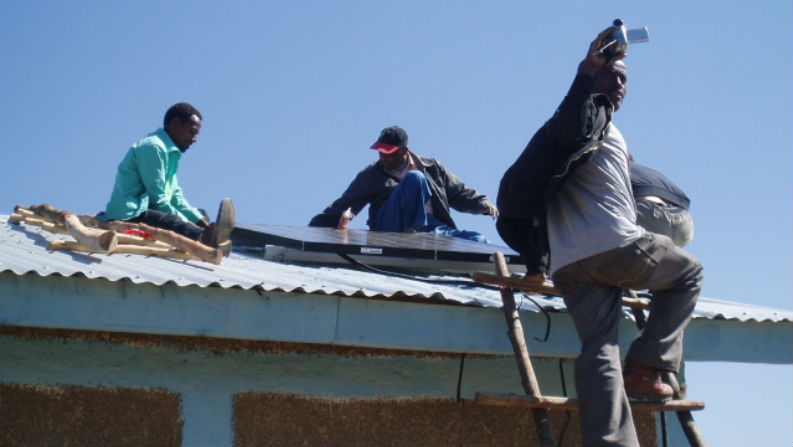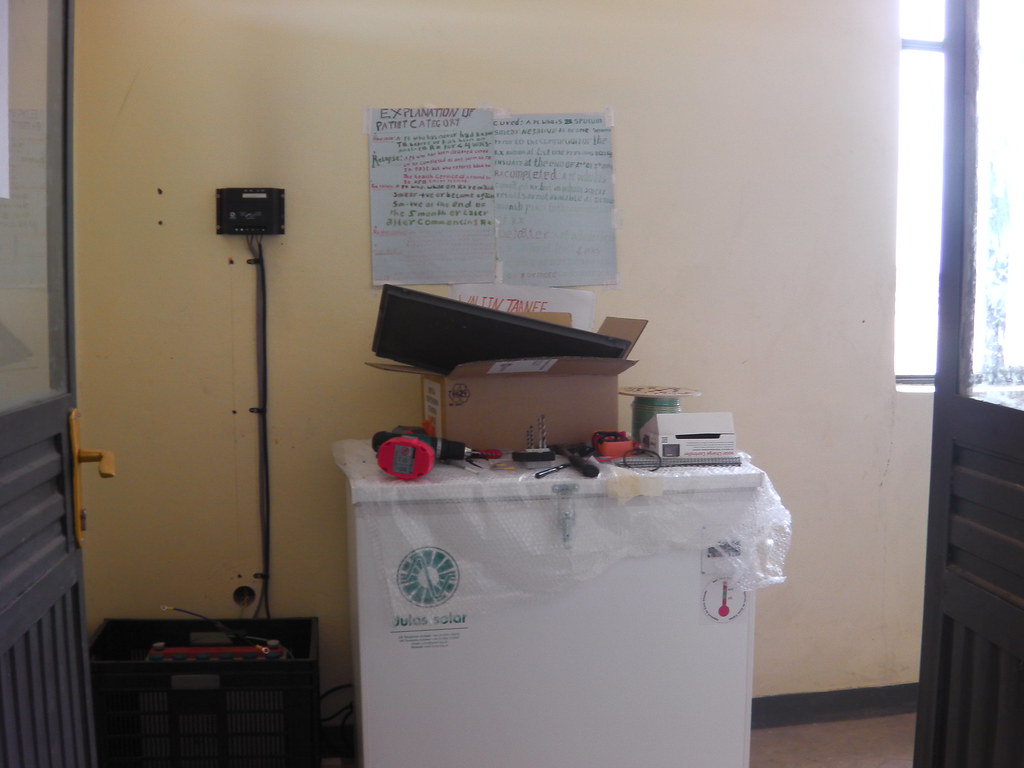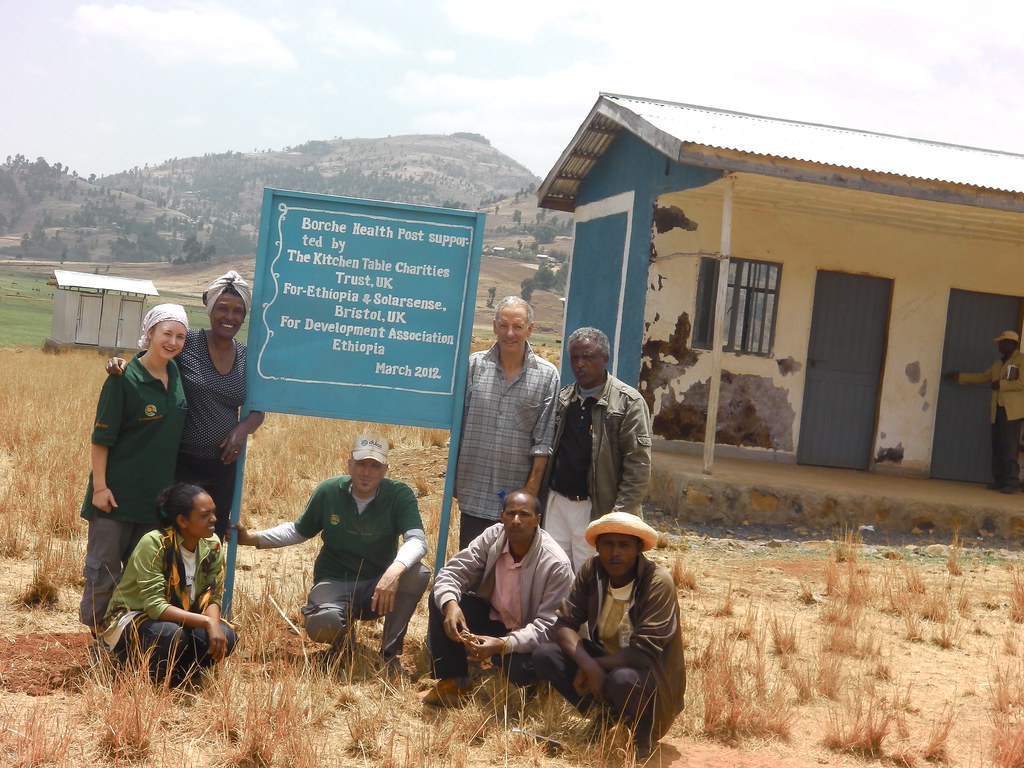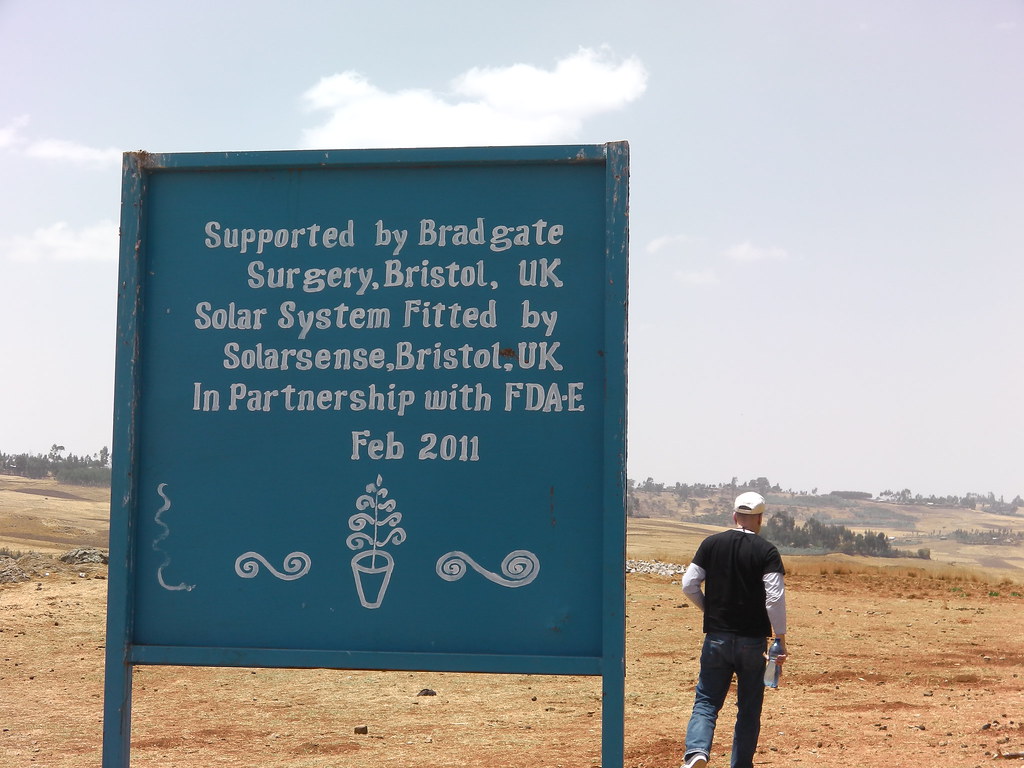Research into replacing Kerosene Fridges
Prior to fitting solar fridges, the health stations in Addis Alem used kerosene fridges to keep their vaccines below the required eight degree Celsius. They had served the stations well enough, but were costly and rather unreliable and so lots of the vaccines spoilt. What we needed was a cheaper source of power to run a well-insulated fridge and freezer and the solution came in the way of solar fridges.
At a garden party, Sue and I were introduced to Richard St Vincent, who was prominent in setting up the Centre for Alternative technology (CAT) based in North Wales. A nearby company, DULAS, was exporting solar fridges all over the world, mainly via UNICEF. We were intrigued and a few months later, the first solar fridge was on its way to Ethiopia. After lots of talk and dealings at the airport, thanks to Worknesh, the package finally arrived at the medical station.

The excitement was now building. Kris and myself had been chosen to fit the fridges and would be accompanied by Jenny. We had received pictures and drawings of the medical station, gone over the fitting instructions many times and considered all the problems we might encounter fitting solar panels to a tin roof supported by Eucalyptus trees (there was no You-Tube in those days!) We relied on our wits and a what-could-possibly-go-wrong? attitude.
On a cold February day in 2011, we set off to Addis Ababa on what was to be quite an adventure. Before we left, Sue and Tigist made sure our suitcases were full of clothes, tools and, strangely, After Eight mints, Pringles and Pot Noodles! These proved to be a Godsend, but that’s another story. We also took lots of toys donated by my work colleagues at the hospital.
We were met at the airport by the lovely Worknesh, where a car was waiting to take us into Addis and our hotel for the evening. Addis is a very friendly city and is the third highest capital in the world, which makes it very comfortable climatically. Addis offers more in the way of sightseeing to keep a curious traveller going for a week. With this in mind, we set off to discover this amazing city. Although slightly tired from the journey and the altitude, we enjoyed walking the museums and meeting new people; we even saw a double-decker green Bristol Bus. That was a turn-up!
 During our tour, we met a couple who’d been in the capital a while and recommended we visit a local bar selling raw meat and beer with good music. This offer was too good not to take up, and the rest of the evening was spent singing, drinking, chatting and eating sliced raw beef (my recent quest to go vegetarian was shelved). Needless to say, when the taxi arrived the next day to take us out to Addis Alem we were slightly worse for wear.
During our tour, we met a couple who’d been in the capital a while and recommended we visit a local bar selling raw meat and beer with good music. This offer was too good not to take up, and the rest of the evening was spent singing, drinking, chatting and eating sliced raw beef (my recent quest to go vegetarian was shelved). Needless to say, when the taxi arrived the next day to take us out to Addis Alem we were slightly worse for wear.
Leaving Addis Ababa, the hustle and bustle of the city soon made way for beautiful rolling hills. We stopped on the way for a beautiful walk, which climbed through a forest of Eucalyptus trees to a small monastery. Occasionally we would spot a group of Anubis baboons. This was a fabulous introduction to life in rural Ethiopia and just a few miles from the capital.
First day’s work
As the day broke, we set off into the countryside with a truck full of tools and people. Me being the eldest (or looking the eldest), I got the front seat. The smooth Chinese-built road soon turned into a mud track and four-wheel suspension was needed to take us further into the countryside. Children came to welcome us shouting and running by the vehicle – this was our first glimpse of village life in this fascinating country.
This was a Monday morning like no other. I was in a small village in Ethiopia surrounded by rolling brown and yellowish hills, a few small farm buildings, a school down the hill and the medical station. It comprised a tin roof, a few windows and a blue door. The frame was made from Eucalyptus trees, and the walls were made from straw and mud with a lime-wash finish. We in Britain would call them “eco” – a good basic structure made from locally-sourced materials… well, apart from the tin roof (the very hot tin roof).
We hardly had time to introduce ourselves and study the elevation and construction of the building – a site survey, we’d call it. When the package containing the fridge was being opened, wood and metal straps were being ripped in a frenzy of activity such was the enthusiasm. We soon had the fridge out and solar panels laid out ready to test. At this point we needed to slow down and access the positioning of the solar panels and fridge and work out cable runs. It was a busy day with lots being done around the place, including new guttering and a water butt.
The elevation was perfect. The roof pointed south and was about 22 degrees in pitch and 80 in temperature. It was high up on the hill with not a bit of shade – perfect. We tossed a coin to see who was going to climb the ladder, which was basically two poles and few cross bits of timber lashed on to form the making of a ladder. The brackets which fit the frame to the building have to be very secure to withstand strong winds so securing the frame is the most important part of the installation, so when our eight coach screws tightened onto the frame we were so pleased. We had the fridge in position, frame fixing on the roof, the solar panels connected to the frame, we needed to make a ventilation hole in the wall and fit the panels to complete our first days work. Well, before I could say lets look at putting the hole here, my best long handled screwdriver was coming through the wall much to the delight of my new work colleague who, if he had continued at this current rate of hammering, would have made a hole big enough to walk through, luckily a translator was on hand to let him know it was a four inch hole not four foot. I replaced the screwdriver with a more appropriate chisel, bingo we had a vent hole. Just the panels to fit and we are done but first a break and a game of cricket, hardly time to explain the rules and we had lots of children and adults bashing a ball and running around all over the place . For lunch pot noodles and melted After Eights. We loved it.

Pot Noodle lunch!
Fitting the panels
A large crowd had gathered and they all wanted to help which was fabulous (not work shy these guys), a lovely gent arrived with a suit jacket and hat and after numerous photos and introduction, we set about hauling the panels onto the roof, another ladder had arrived and with two on the ground and two on the roof, we started to lift the panels. The roof creaked and the ladders bent but eventually the panels were on the roof and tied into our brackets.
We returned the next day to complete the electrics, belt and brace the panels and ran a few tests on the fridge.
It was only three days working on this trip but i am extremely grateful to be given the opportunity to visit Ethiopia and get right inside the country. On the Wednesday afternoon, after going over the instructions on working with the new fridge, we visited the school. It was an overwhelming reception and of course we had to play football. It was during the game I had time to look around at the children the surrounding hills. It was Wednesday afternoon and here I was playing football on the plains of East Africa in a remote village, it don’t get much better!





